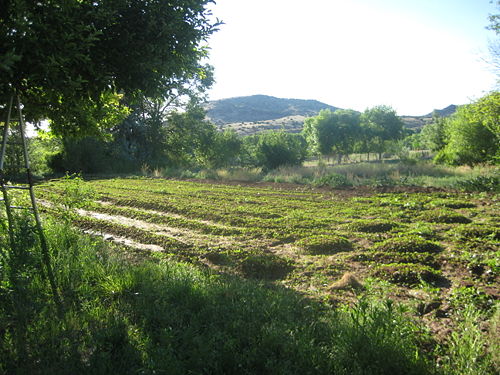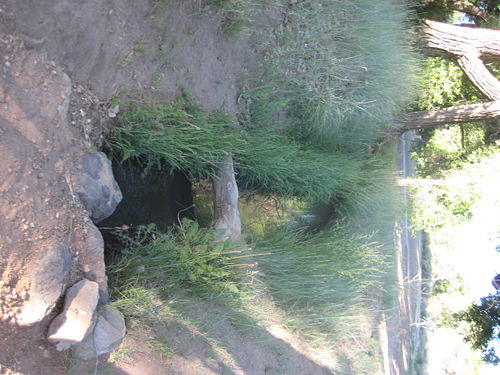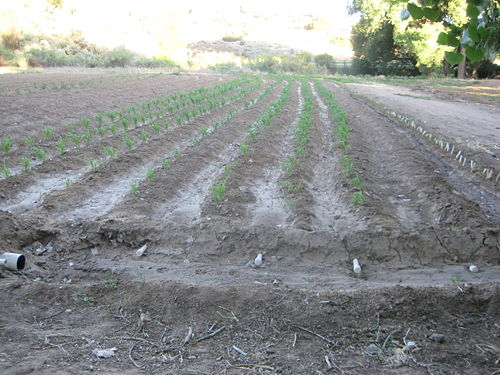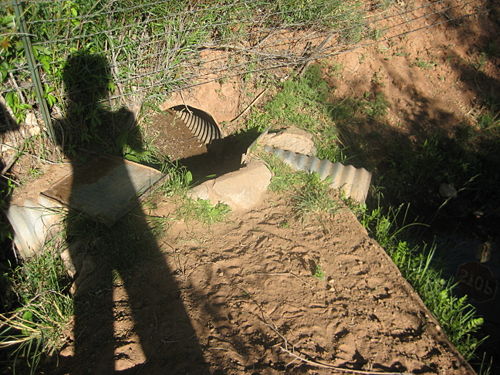Acequias: Difference between revisions
From Santa Fe Institute Events Wiki
No edit summary |
No edit summary |
||
| (8 intermediate revisions by 2 users not shown) | |||
| Line 1: | Line 1: | ||
== Short Abstract == | |||
Common pool natural resources, in particular water, are managed around the world using different management approaches. For instance, some countries have allocated private property rights while others use common property regimes to manage their water resources. In New Mexico so-called ‘acequias’ are a form of community-based irrigation and water governance system. In the latter part of their approximately 400 year existence, there is increasing evidence of friction both internally and externally to the acequia structure. A question is therefore posed as to how the physical and social structure of the acequias can be continued amidst the internal and external pressures being imposed upon the acequias. | |||
== -- == | |||
http://maps.google.com/maps/ms?ie=UTF8&hl=en&msa=0&msid=113886414929155427208.00048934832c87cea712e&t=h&ll=34.2943,-106.6686&spn=4.5638,4.865&output=embed | http://maps.google.com/maps/ms?ie=UTF8&hl=en&msa=0&msid=113886414929155427208.00048934832c87cea712e&t=h&ll=34.2943,-106.6686&spn=4.5638,4.865&output=embed | ||
| Line 29: | Line 33: | ||
JP, Kim, Ingrid, Anne, Zoe, Rajani, Andreas, Sarah | JP, Kim, Ingrid, Anne, Zoe, Rajani, Andreas, Sarah | ||
==Research questions== | ==Research questions== | ||
| Line 62: | Line 63: | ||
etc. | etc. | ||
STAKEHOLDER ANALYSIS FROM THE MEETING: [[Media:stakeholders.xls]] | |||
==Introductory text== | |||
What are Acequias? | |||
Acequias are community-based systems of irrigation and water governance. Acequias are mostly traditional, earthen irrigation ditches, although concrete structures exist. An acequia also refers to the community of farmers that cooperatively maintain the ditch and share water through custom and tradition. Acequias formed the basis for settlement of New Mexico’s Indo-Hispano communities between two and four hundred years ago. | |||
Why are Acequias important? | |||
Water is viewed as the lifeblood of the New Mexico communities because it keeps the community together. Water is essential to the continued survival of a traditional way of life. Acequias continue to be vital to the cultural and economic survival of the traditional communities of New Mexico. | |||
How are Acequias governed? | |||
The principles and cultural practices referred to as the “repartimiento” guide the allocation of water within acequias and between acequias. Each Mayordomo, who is democratically elected, is responsible for distributing water within his or her respective acequia. By custom, Mayordomos on the same stream system agree on a system to share water between acequias. | |||
What are the threats? | |||
* Unprecedented growth and demand for water. | |||
* Subdivision pressures / urban sprawl | |||
* Changing/reduced incentives to maintain Acequia infrastructure | |||
What are the benefits? | |||
* Economic, social and cultural benefits | |||
* Water delivery to home garden | |||
* Water delivery to market garden crops | |||
* Shared goal of the community of water users | |||
* Maintaining traditional agricultural practices | |||
Ecological/ecosystem benefits (from study by Sam Fernald and Steve Guldan, NMSU’s Sustainable * Agriculture Science Center at Alcalde) | |||
* Seepage back into the groundwater through the irrigated land | |||
* Seepage affects/improves groundwater quality through diluting contaminants in the groundwater | |||
* Better-quality water that is recharging the aquifer and going back to the river | |||
* Better-quality water returns to the river (93 percent of irrigated water: 60 percent as surface water from irrigation tailwater and 33 percent as groundwater). | |||
Ecosystem costs of acequias | |||
* Water lost to evapotranspiration. This is estimated to be only small (7 percent of the water diverted from the Rio Grande into a north-central New Mexico acequia irrigation system is lost to evapotranspiration) | |||
==Photos== | |||
[[Image:acequia1.jpg|500px|acequia]] | |||
Acequia-watered farmland | |||
[[Image:acequia2.jpg|500px|acequia]] | |||
Sign at Rancho de las Golondrinas | |||
[[Image:acequia3.jpg|500px|acequia]] | |||
At Rancho de las Golondrinas | |||
[[Image:acequia4.jpg|500px|acequia]] | |||
At Rancho de las Golondrinas - closer look at water use | |||
[[Image:acequia5.jpg|500px|acequia]] | |||
Acequia use on personal land | |||
[[Image:acequia6.jpg|500px|acequia]] | |||
JP, fearless leader. | |||
Latest revision as of 03:37, 25 June 2010
Short Abstract
Common pool natural resources, in particular water, are managed around the world using different management approaches. For instance, some countries have allocated private property rights while others use common property regimes to manage their water resources. In New Mexico so-called ‘acequias’ are a form of community-based irrigation and water governance system. In the latter part of their approximately 400 year existence, there is increasing evidence of friction both internally and externally to the acequia structure. A question is therefore posed as to how the physical and social structure of the acequias can be continued amidst the internal and external pressures being imposed upon the acequias.
--
Notes from meeting on 15th
Statement of Goals
Want to address questions of environmental impact of traditional farming, stability.
- where is it ok to develop? Where should we work on preservation?
- Where are these fundamentally tied to economy and social situation?
- What kind of development is ok for the system?
- "if you develop this in way X rather than way Y, what will the difference be?"
Suggest that we promote maintenance of acequias, prevent division of land, present pressures on the acequia system by suburbanization Want more data to do this well.
Data
We have:
- point data (KML file)
- demographic data (census tracts)
- USGS map data for the area
We want:
- shapefiles
- more census data
- Census: American Community Surveys?
People present
JP, Kim, Ingrid, Anne, Zoe, Rajani, Andreas, Sarah
Research questions
- What is the social, cultural, economic, ecological, political significance of A?
- What are the developments that have an impact on these elements?
- What metrics of these developments do we have?
- Who are the stakeholders in the A?
- What institutional arrangements exist for A?
- What are their relationships, what is their interest, what power do they have?
- What is the geographic distribution of A?
- What geographic features that influence A (gradient, rainfall, wells, temp, ...?)?
Stakeholder analysis
| Stakeholder | Interest | Power |
| Farmers | Agriculture | Voting? Protesting? |
| Home owners | Land value | Voting? |
| State gov't | ||
| Municipality | ||
| Real estate dev't | ||
| Acequia association |
etc.
STAKEHOLDER ANALYSIS FROM THE MEETING: Media:stakeholders.xls
Introductory text
What are Acequias? Acequias are community-based systems of irrigation and water governance. Acequias are mostly traditional, earthen irrigation ditches, although concrete structures exist. An acequia also refers to the community of farmers that cooperatively maintain the ditch and share water through custom and tradition. Acequias formed the basis for settlement of New Mexico’s Indo-Hispano communities between two and four hundred years ago.
Why are Acequias important? Water is viewed as the lifeblood of the New Mexico communities because it keeps the community together. Water is essential to the continued survival of a traditional way of life. Acequias continue to be vital to the cultural and economic survival of the traditional communities of New Mexico.
How are Acequias governed? The principles and cultural practices referred to as the “repartimiento” guide the allocation of water within acequias and between acequias. Each Mayordomo, who is democratically elected, is responsible for distributing water within his or her respective acequia. By custom, Mayordomos on the same stream system agree on a system to share water between acequias.
What are the threats?
- Unprecedented growth and demand for water.
- Subdivision pressures / urban sprawl
- Changing/reduced incentives to maintain Acequia infrastructure
What are the benefits?
- Economic, social and cultural benefits
- Water delivery to home garden
- Water delivery to market garden crops
- Shared goal of the community of water users
- Maintaining traditional agricultural practices
Ecological/ecosystem benefits (from study by Sam Fernald and Steve Guldan, NMSU’s Sustainable * Agriculture Science Center at Alcalde)
- Seepage back into the groundwater through the irrigated land
- Seepage affects/improves groundwater quality through diluting contaminants in the groundwater
- Better-quality water that is recharging the aquifer and going back to the river
- Better-quality water returns to the river (93 percent of irrigated water: 60 percent as surface water from irrigation tailwater and 33 percent as groundwater).
Ecosystem costs of acequias
- Water lost to evapotranspiration. This is estimated to be only small (7 percent of the water diverted from the Rio Grande into a north-central New Mexico acequia irrigation system is lost to evapotranspiration)
Photos
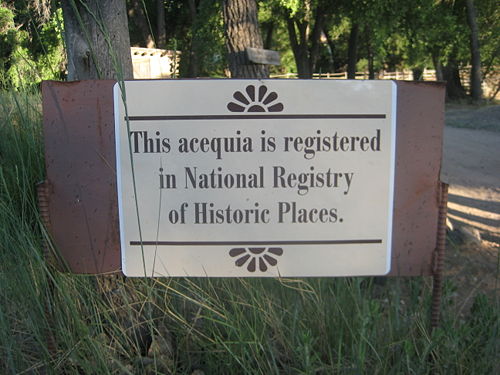 Sign at Rancho de las Golondrinas
Sign at Rancho de las Golondrinas

